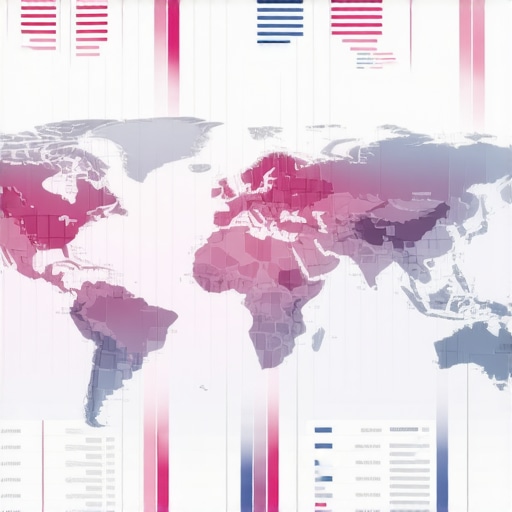My Journey into Maps Analytics and Local SEO: A Personal Perspective
Whenever I think about how far my local business has come, I can’t help but remember the early days of trial and error. I vividly recall the times I struggled to understand why certain strategies worked while others didn’t. My breakthrough came when I started leveraging Maps Analytics and Local SEO reports, which transformed my approach and results.
By diving deep into Maps Analytics, I learned how to interpret customer behavior, map engagement, and pinpoint where my marketing efforts made the biggest impact. This was a game-changer—helping me optimize my Google My Business (GMB) profile and local keywords effectively.
Why Maps Analytics is Your Secret Weapon for 2025
As I kept exploring, I realized that Maps Analytics isn’t just about data—it’s about actionable insights. For instance, I discovered that tracking how customers find my location and interact with my GMB profile directly influences my local rankings. According to Effective Maps Analytics strategies, integrating these insights into my SEO efforts boosted my visibility significantly.
This is why I now prioritize comprehensive local SEO reports. They help me identify gaps, refine my keywords, and improve my overall local marketing strategy for 2025 and beyond.
What’s the Real Power Behind Local SEO Reports?
The real power lies in performance tracking. I remember using detailed GMB performance reports to see which posts, keywords, or services attracted the most attention. Not only did this help me understand my audience better, but it also allowed me to make data-driven decisions that heightened my local search presence.
Tools like GMB performance reports are invaluable—they give me clear insights into how my listings perform and what I can do to improve ranking factors. It’s like having a personal coach guiding my local SEO journey.
How Can I Optimize My Maps Analytics for Better Results?
Great question. I found that regularly reviewing my Maps analytics data and combining it with keyword tracking helped me stay ahead of local competitors. Setting up a ranking tracker was especially useful in monitoring my progress over time.
If you’re serious about dominating local search in 2025, I highly recommend exploring these tools and reports. They truly are your best allies in building a resilient local SEO strategy.
Feel free to share your own experiences or ask questions in the comments—I’m always eager to learn and grow together!
How Can Deep Data Analysis Elevate Your Local SEO in 2025?
As an experienced local marketer, I can attest that the true power of Maps Analytics lies in its ability to reveal nuanced customer behaviors and preferences. By analyzing granular data points—such as customer routes, peak engagement times, and interaction patterns—you gain a comprehensive understanding of your audience. This depth of insight allows for hyper-targeted marketing efforts, ensuring your keywords and content resonate precisely with your local community.
For example, integrating these insights into your SEO KPI dashboards enables real-time adjustments, helping you stay ahead of competitors. Additionally, leveraging Maps Analytics to monitor customer journey touchpoints can significantly improve your conversion rates, turning passive visitors into loyal customers.
What Are the Practical Benefits of Combining Maps Analytics with Local SEO Tactics?
Combining comprehensive Maps Analytics insights with proven SEO tactics creates a powerful synergy. This approach not only enhances your visibility but also ensures your marketing efforts are data-driven and measurable. For instance, optimizing your local SEO KPIs based on analytics data leads to more accurate ranking improvements and better resource allocation.
Furthermore, aligning your ranking tracker with real-time map data allows for dynamic strategy adjustments—an essential tactic in the ever-evolving local search landscape of 2025.
Can Advanced Analytics Help Small Businesses Compete with Larger Brands?
Absolutely. In fact, sophisticated Maps Analytics tools level the playing field by providing small businesses with actionable insights that were once only accessible to large corporations. By meticulously tracking customer interactions, review patterns, and local search trends, small businesses can craft highly personalized marketing campaigns that drive local engagement and foster community loyalty.
For instance, understanding which services or products garner the most attention in specific neighborhoods allows tailoring offers, boosting local relevance. This strategic advantage underscores why integrating analytics into your local SEO approach is no longer optional but essential.
To deepen your strategy, I recommend exploring critical reports for 2025—they provide actionable insights to refine your local marketing initiatives further. And remember, sharing your experiences or questions in comments can spark new ideas and collaborations that propel your local SEO efforts forward!
Unearthing Nuanced Customer Behaviors: My Personal Deep Dive into Maps Analytics
When I first started integrating Maps Analytics into my local marketing efforts, I was surprised by how much I was missing in the granular data. Initially, I focused on broad metrics—total clicks, calls, and directions—but soon realized that this was just scratching the surface. Diving deeper, I uncovered patterns in customer routes, peak engagement times, and interaction touchpoints that truly transformed my strategy.
For example, analyzing customer routes revealed neighborhoods where my outreach was resonating most, prompting me to tailor my local campaigns specifically for those areas. Tracking engagement times helped me schedule posts and promotions during peak periods, ensuring maximum visibility. This level of detailed insight required me to shift from a reactive to a proactive approach, constantly refining my tactics based on real-time data.
Advanced Analytics: The Secret to Hyper-Targeted Marketing
One question I often get is, “How can small businesses leverage advanced analytics without breaking the bank?” Honestly, the key is to start with accessible tools and focus on interpreting the data correctly. I found that integrating SEO KPI dashboards helped me visualize complex data in a digestible format, enabling me to make informed decisions swiftly.
By meticulously analyzing these insights, I could identify underserved niches or service gaps that my competitors overlooked. This hyper-targeted approach meant I could allocate my marketing resources more efficiently, focusing on high-impact areas. The payoff? Better rankings, increased local engagement, and a stronger community presence.
How Do You Balance Data-Driven Decisions with Authentic Local Engagement?
That’s a nuanced challenge I grappled with—finding the sweet spot between automation and genuine community interaction. Data provides the map, but authentic engagement is what truly builds loyalty. I learned to use insights from Maps Analytics to create personalized messages and offers that resonate locally, rather than relying on generic templates.
For instance, if analytics show increased interest in a particular service, I craft stories or posts around that theme, sharing behind-the-scenes moments or customer testimonials. This blend of data and authenticity helps foster trust and encourages word-of-mouth referrals.
Sharing your experiences or asking questions in comments can open new avenues for growth. How are you using analytics to deepen your local relationships? I’d love to hear your stories!
Deepening Strategy with Strategic Reports: The Next Frontier
Another area I’ve found invaluable is leveraging strategic reports for 2025. These reports don’t just compile data—they provide actionable insights, highlighting trends and opportunities that are easy to overlook. For example, I discovered emerging keywords and search behaviors that I hadn’t considered, allowing me to pivot my content strategy before my competitors caught on.
This proactive approach keeps my business ahead, especially when combined with GMB performance reports. Regularly reviewing these insights helps me stay aligned with current customer preferences and local market dynamics.
Curious about how these insights can work for your business? Dive into the comprehensive reports for 2025 and explore new ways to elevate your local SEO game. And don’t forget—sharing your experiences or questions can spark valuable conversations that propel your strategy forward!
Unlocking Hidden Customer Journeys with Deep Data Dive
As I delved further into the intricacies of Maps Analytics, I realized that the true power lies in uncovering the subtle nuances of customer behavior. Beyond basic metrics, I began analyzing specific route patterns and engagement touchpoints that revealed unexpected opportunities for targeted marketing. For example, tracking customer routes in underserved neighborhoods allowed me to craft hyper-local campaigns that resonated deeply, fostering stronger community ties and increasing conversions.
This granular level of data analysis also helped me identify previously overlooked peak times for customer interactions. By aligning my promotional efforts with these insights, I optimized visibility during high-traffic periods, ensuring my messages hit at precisely the right moments. Such strategic adjustments, grounded in sophisticated data interpretation, significantly boosted my local search rankings and customer engagement rates.
Harnessing External Expertise to Refine Your Strategy
Integrating external authoritative insights has been instrumental in sharpening my approach. For instance, according to a detailed review on Maps Analytics report strategies for 2025, leveraging advanced analytics tools can provide actionable insights that drive measurable results. These resources have guided me in fine-tuning my data collection methods and optimizing my reporting frameworks, ensuring I stay ahead of evolving local search algorithms.
Moreover, adopting a holistic view by combining local SEO reports with comprehensive SEO KPI dashboards has enabled me to monitor performance in real time and adjust tactics proactively. This dynamic approach has made my campaigns more agile, allowing rapid iteration based on fresh data—an essential advantage in the fast-paced landscape of 2025.
Encouraging Community and Peer Engagement
While data-driven insights are invaluable, I’ve found that fostering genuine community engagement amplifies results. Sharing my experiences in leveraging Maps Analytics and local SEO strategies often sparks meaningful conversations with fellow entrepreneurs. I invite you to join the dialogue—what innovative tactics have you employed recently? How do you balance sophisticated analytics with authentic local interactions?
Engaging with peers not only broadens your perspective but also uncovers new tools and techniques that can elevate your strategy. Remember, the most successful local businesses are those that blend data intelligence with heartfelt community connection. Dive deeper into these insights by exploring our comprehensive critical reports for 2025—they might just hold the key to your next breakthrough.
Things I Wish I Knew Earlier (or You Might Find Surprising)
The Hidden Power of Customer Routes
When I first started using Maps Analytics, I focused mainly on surface metrics like clicks and calls. It wasn’t until I analyzed customer routes that I discovered neighborhoods where my outreach truly resonated. This insight allowed me to tailor my local campaigns more effectively, making my marketing more targeted and impactful.
Peak Engagement Times Are Closer Than You Think
Initially, I scheduled posts and promotions at random times, hoping for the best. But diving into Maps Analytics data revealed specific peak times for customer interactions. Aligning my marketing efforts with these periods boosted my visibility and engagement significantly.
Data Can Be Your Best Friend and Your Worst Enemy
At first, I was overwhelmed by the volume of data. But I learned that with the right tools, like SEO KPI dashboards, I could distill insights into actionable steps. It’s all about knowing what to focus on and not getting lost in the numbers.
Authentic Engagement Wins Over Automation
While analytics help identify opportunities, genuine community interaction remains key. I use insights to craft personalized messages and share behind-the-scenes stories, fostering real connections that translate into loyal customers and positive reviews.
Resources I’ve Come to Trust Over Time
- Google’s My Business Insights: A foundational resource that offers direct data on how your listing performs, helping me understand customer behavior firsthand.
- BrightLocal: A trusted platform for local SEO audits and reporting, which has helped me refine my strategy with comprehensive insights.
- Local SEO Guide: An authoritative blog that keeps me updated on the latest trends and tactics, ensuring my efforts stay current and effective.
- Google’s Official Blog: For updates on algorithm changes and new features, which directly impact how I interpret my analytics data.
Parting Thoughts from My Perspective
Exploring the depths of Maps Analytics has profoundly changed my approach to local SEO. The key takeaway? Data-driven insights are powerful, but they work best when combined with authentic community engagement. As I look ahead to 2025, I believe the most successful local businesses will be those that leverage these tools intelligently and genuinely connect with their audiences. If this resonated with you, I’d love to hear your thoughts—feel free to share your experiences or ask questions. Let’s grow our local presence together!


